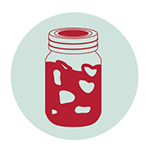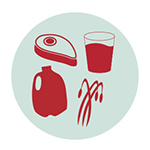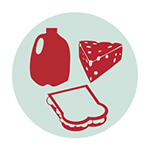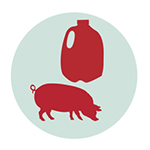What are the symptoms of food poisoning?

Food poisoning is no fun. In most cases, your body will heal itself as long as you drink plenty of fluids until the GI problems clear up.
Sometimes, though, you’re going to need medical help, especially if you’re older, have a weakened immune system, or have severe or long-lasting symptoms. (Infants and pregnant women are also more likely to have a serious bout.)
What are the culprits?
Here are the bacteria, toxins, viruses, and parasites in food that are most likely to make you sick and their common food sources.
Bacillus cereus
 | Often grows in foods that aren’t kept at the proper temperature. Less commonly causes vomiting syndrome, which causes minimal diarrhea or abdominal pain and is associated with fried rice. Common food sources: Meats, stews, gravies, leftovers. |
Campylobacter jejuni
 | One of the most common causes of diarrhea in the U.S. Common food sources: Undercooked poultry, raw milk. |
Ciguatera
 | Illness caused by an odorless, tasteless neurotoxin that contaminates some tropical reef fish and that is not destroyed by cooking. Common food sources: Barracuda, amberjack, large groupers and snappers. |
Clostridium botulinum (botulism)
 | Rare, but can be deadly if not treated. Caused by a toxin that can be inactivated by cooking. Common food sources: Improperly home-canned foods. |
Clostridium perfringens
 | Often grows in foods that aren’t kept at the proper temperature by restaurants, cafeterias, or caterers. Common food sources: Improperly cooled or stored prepared foods, particularly meats and gravies. |
Cyclospora
 | A parasite spread by food or water contaminated with feces. Common food sources: Imported berries, imported lettuce. |
Enterotoxigenic E. coli
 | The most common cause of “traveler’s diarrhea.” Common food sources: Food or water that has been contaminated by feces. |
E. coli O157:H7
 | A particularly dangerous strain that can be fatal if left untreated. Common food sources: Undercooked beef, raw milk, unpasteurized juice, raw sprouts, contaminated water. |
Listeria monocytogenes
 | One of the leading causes of death from foodborne illness. Primarily strikes older adults, pregnant women, newborns, and people with weakened immune systems. Common food sources: Raw milk, cheeses made with raw milk, deli meats. |
Noroviruses
 | The leading cause of foodborne illness in the U.S. (and on cruise ships). Common food sources: Raw produce, mollusks (oysters, clams, mussels, scallops), food handled by an infected person. |
Salmonella
 | The leading cause of serious foodborne illness in the U.S. Common food sources: Eggs, poultry, meat, raw milk, unpasteurized juice, raw produce. |
Shigella
 | Typically spreads through person-to-person contact or contamination by food handlers. Common food sources: Raw produce. |
Staphylococcus aureus
 | Introduced into foods by food handlers. Produces a toxin that causes severe vomiting. Common food sources: Improperly refrigerated meats, potato salad, egg salad, cream-filled pastries. |
Vibrio parahaemolyticus
 | Found in ocean water along the coast or in estuaries where ocean water mixes with river water. Common food sources: Raw or improperly cooked oysters. |
Yersinia
 | Infection may be misdiagnosed as appendicitis or Crohn’s disease. Common food sources: Undercooked pork, raw milk. |
Which microbe caused your bout of food poisoning?
Click here to download a chart of the symptoms that some of the most common bacteria, toxins, viruses, and parasites in food typically cause, and what to do about them.
Key source: J. Glenn Morris, professor of infectious diseases and director of the Emerging Pathogens Institute at the University of Florida, and co-editor of Foodborne Infections and Intoxications. Other sources: Centers for Disease Control and Prevention, Food and Drug Administration, Marcus Glassman (Food Safety Project, Center for Science in the Public Interest).
Tags
Topics
From the Nutrition Action bookstore
From our team of scientists and nutritionists

Book
From Supermarket to Leftovers
Starting at $25

Book
Chemical Cuisine: Your Guide to Food Additives
Starting at $10

Book
Safe & Easy Steps to Lower Your Blood Pressure
Starting at $10

